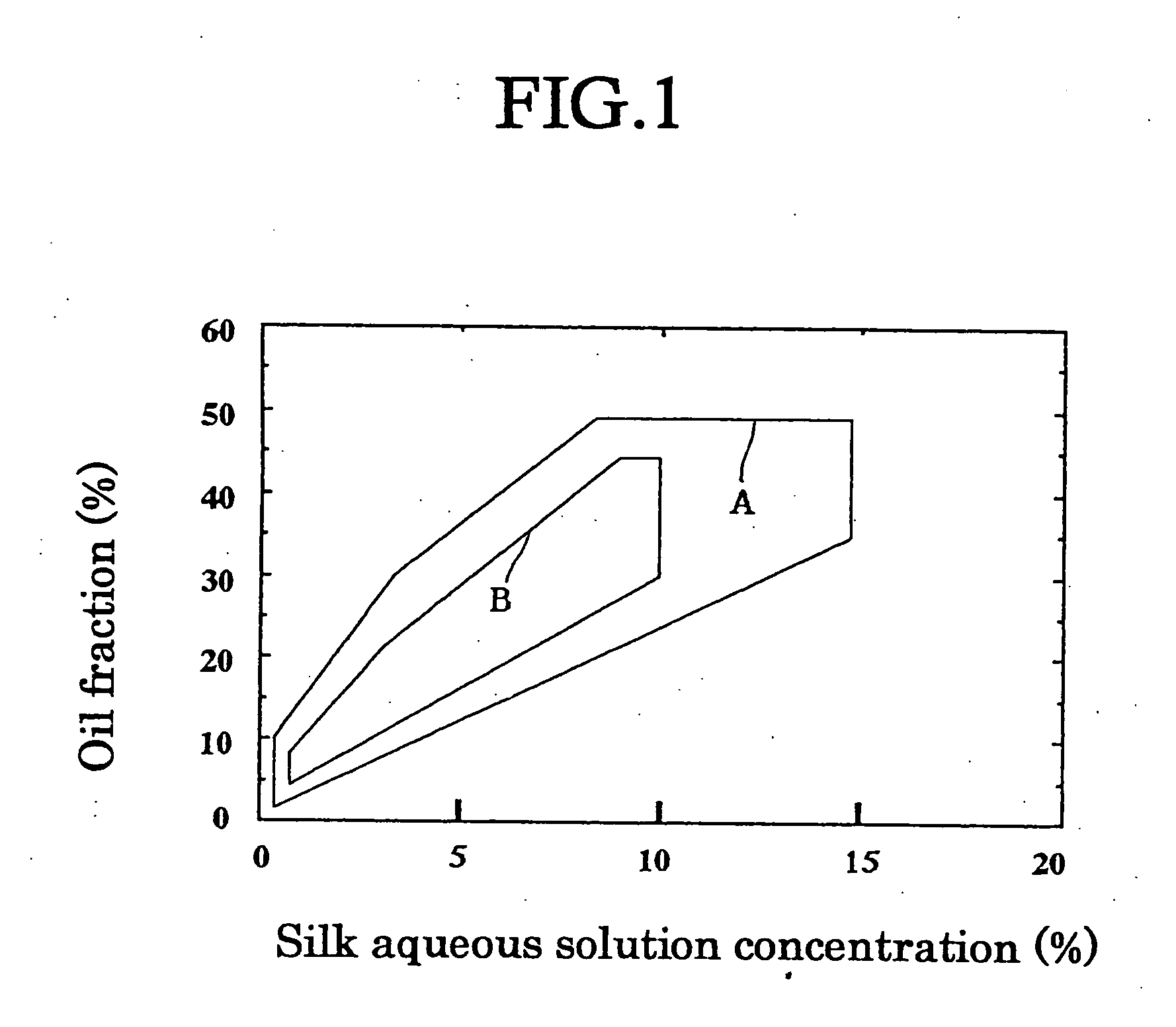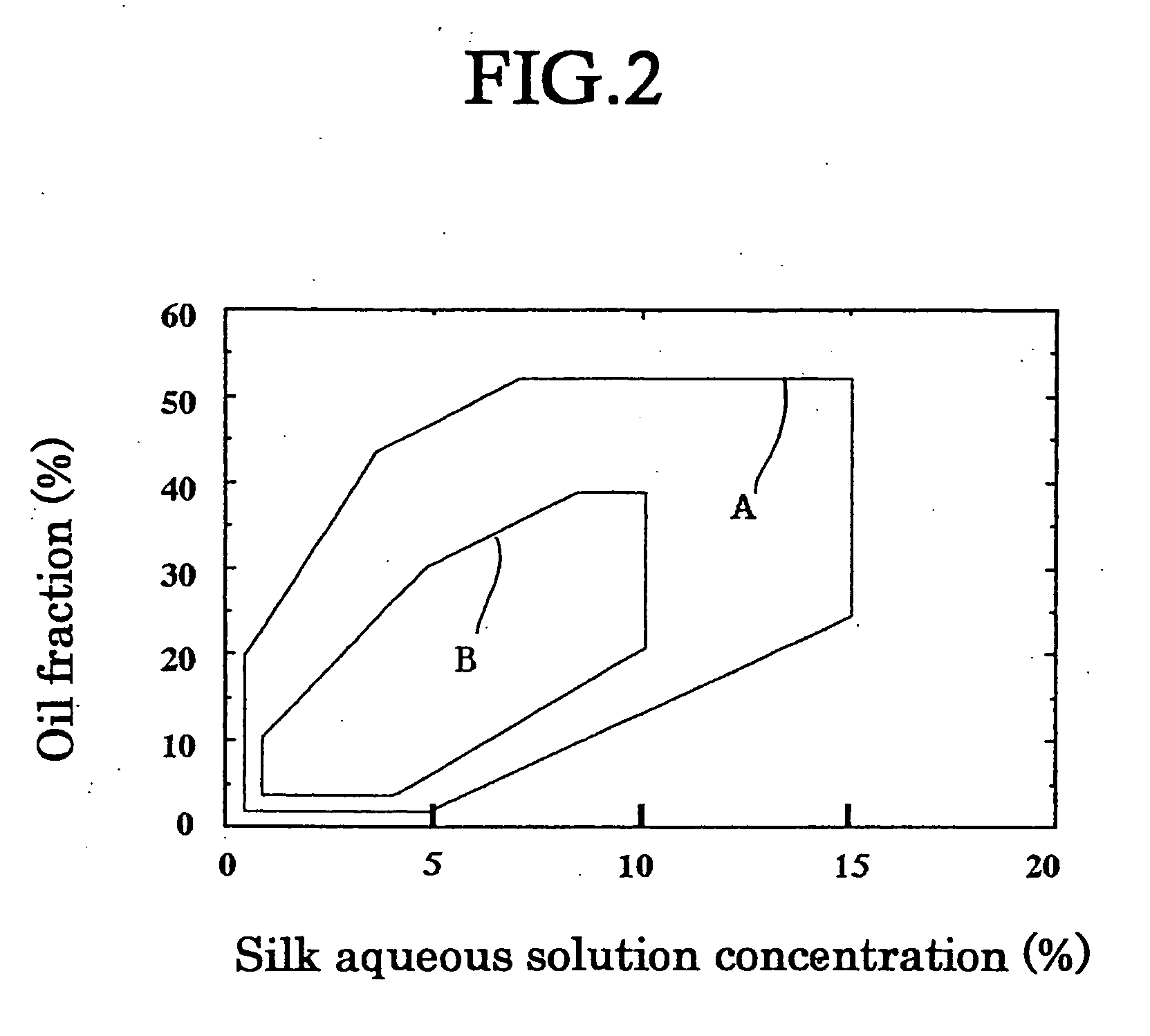Emulsifier and process for producing the same
a technology of emulsifier and process, applied in the direction of mixing, transportation and packaging, chemical apparatus and processes, etc., can solve the problems of not knowing the use of silk protein as an emulsifier for cosmetic materials, lack of spreadability, crumbling feel, etc., to achieve enhanced emulsification power and feel, high skin care performance, and promote skin cell growth
- Summary
- Abstract
- Description
- Claims
- Application Information
AI Technical Summary
Benefits of technology
Problems solved by technology
Method used
Image
Examples
example 2
[0184] Emulsion from Silk Protein Aqueous Solution Prepared from Dried Amorphous Silk Protein (Film or Powder)
[0185] The 4.0% concentration silk protein aqueous solution prepared in Example 1 was cast onto a plastic sheet in a chamber at 25.degree. C., 40% RH and dried with air blowing to fabricate a silk film.
[0186] The obtained amorphous silk film was immersed in water at 20.degree. C. and dissolved to prepare silk protein aqueous solutions with concentrations of 6.0%, 4.0%, 2.0% and 1.0%.
[0187] In the same manner as Example 1, olive oil was added to these solutions and mixing was carried out for emulsification.
[0188] Evaluation of the relationship between the silk protein aqueous solution concentration and oil fraction of each emulsion suitable for use as a cosmetic material provided the same results shown in FIG. 1.
example 3
[0189] Emulsification of Oily Component with Silk Protein Aqueous Gel
[0190] A 300 g portion of domesticated silkworm cocoon shell was immersed in a boiling solution containing 6 g of sodium carbonate and 12 liters of water and then scoured for 60 minutes.
[0191] A 195 g portion of this silk yarn was dissolved in a solution containing 392 g of calcium chloride, 508 g of water and 325 g of ethanol.
[0192] The temperature of the solution was 75-85.degree. C., and the dissolution time was 3 hours.
[0193] Dialysis was performed with tap water for the first two days, followed by two days with purified water, replaced 8 times.
[0194] No fibroin H chains or L chains were found in the electrophoresis image for the silk aqueous solution, and the average molecular weight was approximately 65,000 based on gel chromatography.
[0195] The concentration of the silk aqueous solution was 14.1%.
[0196] Solutions with concentrations of 6.0%, 3.0%, 1.0% and 0.2% were also prepared, and these were allowed to s...
example 4
[0203] Preparation of Silk Protein Aqueous Gels:
[0204] A 300 g portion of domesticated silkworm cocoon shell was immersed in a boiling solution (approximately 100.degree. C.) containing 6 g of sodium carbonate and 12 liters of water, and then scoured for 60 minutes.
[0205] A 150 g portion of this silk yarn was dissolved in a solution containing 392 g of calcium chloride, 508 g of water and 325 g of ethanol.
[0206] The temperature of the solution was 75-85.degree. C., and the dissolution time was 2 hours.
[0207] Dialysis was performed with tap water for the first two days, followed by two days with purified water, replaced 8 times.
[0208] No fibroin H chains or L chains were found in the electrophoresis image for the silk protein aqueous solution, and the average molecular weight was approximately 130,000 based on gel chromatography.
[0209] The obtained silk protein aqueous solution with a 9.41% concentration was diluted with water to prepare additional silk protein aqueous solutions with...
PUM
| Property | Measurement | Unit |
|---|---|---|
| Fraction | aaaaa | aaaaa |
| Fraction | aaaaa | aaaaa |
| Fraction | aaaaa | aaaaa |
Abstract
Description
Claims
Application Information
 Login to View More
Login to View More - R&D
- Intellectual Property
- Life Sciences
- Materials
- Tech Scout
- Unparalleled Data Quality
- Higher Quality Content
- 60% Fewer Hallucinations
Browse by: Latest US Patents, China's latest patents, Technical Efficacy Thesaurus, Application Domain, Technology Topic, Popular Technical Reports.
© 2025 PatSnap. All rights reserved.Legal|Privacy policy|Modern Slavery Act Transparency Statement|Sitemap|About US| Contact US: help@patsnap.com



